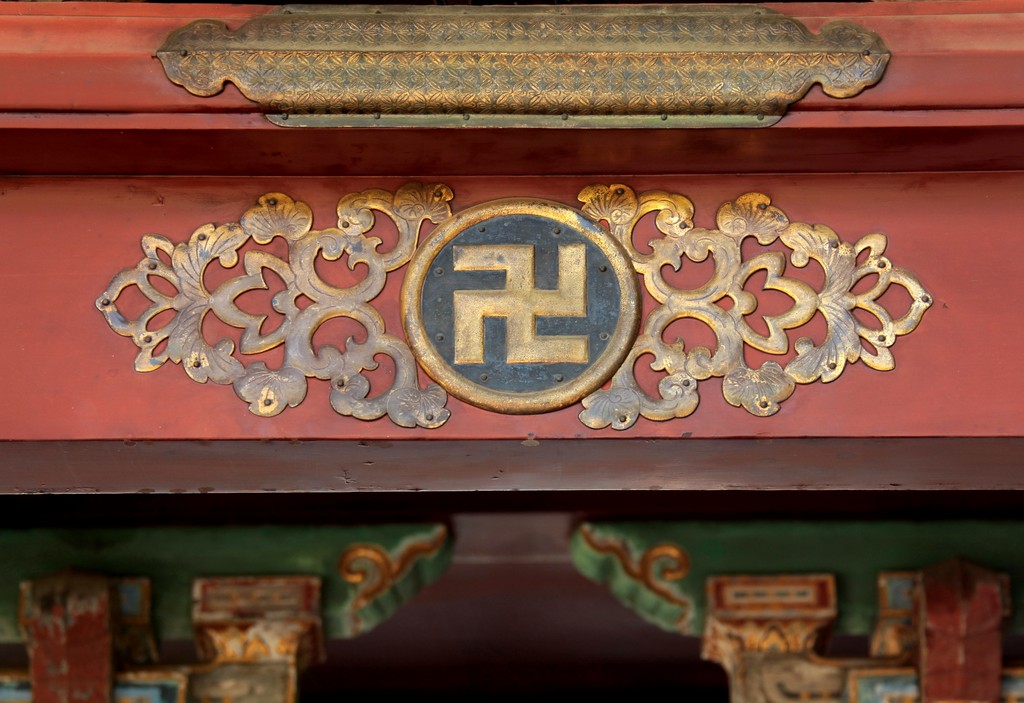SVASTIKA DANS UN TEMPLE
Le svastika ou swastika 卐, mot sanskrit dérivé de su («bien») et de asti («il est»), avec la variante orthographique sauvastika parfois attribuée à son symétrique sinistrogyre 卍, est un symbole que l'on retrouve en Eurasie, en Afrique, en Océanie, aux Amériques (Amérique précolombienne chez les Mayas et amérindiens Navajos et kunas) et en Extrême-Orient. Son apparition se fait dès l'époque néolithique où il apparait dans la pré-écriture de la culture de Vinča. On peut le décrire comme une croix composée de quatre potences prenant la forme d'un gamma grec en capitale (Γ), d'où le nom de croix gammée qui lui est parfois donné depuis son apparition dans l'art chrétien et byzantin primitif.
Ce symbole est notamment utilisé en Asie dans la symbolique jaïne, hindoue et bouddhique, en Chine pour symboliser l'éternité et dans l'Asie bouddhiste. En Occident, le svastika pointant vers la droite, et généralement incliné de 45 degrés, a été adopté comme emblème par les nazis et a par conséquent acquis après la Seconde Guerre mondiale une forte connotation négative. Certaines factions politiques minoritaires et extrémistes l'utilisent pour se rattacher directement à cette idéologie.
En Asie, et tout particulièrement en Inde, c'est toujours un symbole omniprésent. Il symbolise, parmi d'autres sens, le très populaire dieu Ganesh et est le symbole premier du jaïnisme, considéré par ses adeptes comme le plus favorable de tous les symboles.
---------------------------------------------
The swastika (Sanskrit: स्वस्तिक) is an equilateral cross with four arms bent at 90 degrees. The earliest archaeological evidence of swastika-shaped ornaments dates back to the Indus Valley Civilization as well as the Mediterranean Classical Antiquity and paleolithic Europe. Swastikas have also been used in various other ancient civilizations around the world including India, Iran, Nepal, China, Japan, Korea and Europe. It remains widely used in Indian religions, specifically in Hinduism, Buddhism, and Jainism, primarily as a tantric symbol to evoke shakti or the sacred symbol of auspiciousness. The word "swastika" comes from the Sanskrit svastika - "su" meaning "good" or "auspicious," "asti" meaning "to be," and "ka" as a suffix. The swastika literally means "to be good". Or another translation can be made: "swa" is "higher self", "asti" meaning "being", and "ka" as a suffix, so the translation can be interpreted as "being with higher self".
The symbol has a long history in Europe reaching back to antiquity. In modern times, following a brief surge of popularity as a good luck symbol in Western culture, a swastika was adopted as a symbol of the Nazi Party of Germany in 1920, who used the swastika as a symbol of the Aryan race. After Adolf Hitler came to power in 1933, a right-facing 45° rotated swastika was incorporated into the flag of the Nazi Party, which was made the state flag of Germany during the Nazi era. Hence, the swastika has become strongly associated with Nazism and related concepts such as antisemitism, hatred, violence, death, and murder in many western countries, and is now largely stigmatized there due to the changed connotations of the symbol Notably, it has been outlawed in Germany and other countries if used as a symbol of Nazism in certain instances. Many modern white nationalist and Neo-Nazi groups such as the Russian National Unity use stylized swastikas or similar symbols.
Ce symbole est notamment utilisé en Asie dans la symbolique jaïne, hindoue et bouddhique, en Chine pour symboliser l'éternité et dans l'Asie bouddhiste. En Occident, le svastika pointant vers la droite, et généralement incliné de 45 degrés, a été adopté comme emblème par les nazis et a par conséquent acquis après la Seconde Guerre mondiale une forte connotation négative. Certaines factions politiques minoritaires et extrémistes l'utilisent pour se rattacher directement à cette idéologie.
En Asie, et tout particulièrement en Inde, c'est toujours un symbole omniprésent. Il symbolise, parmi d'autres sens, le très populaire dieu Ganesh et est le symbole premier du jaïnisme, considéré par ses adeptes comme le plus favorable de tous les symboles.
---------------------------------------------
The swastika (Sanskrit: स्वस्तिक) is an equilateral cross with four arms bent at 90 degrees. The earliest archaeological evidence of swastika-shaped ornaments dates back to the Indus Valley Civilization as well as the Mediterranean Classical Antiquity and paleolithic Europe. Swastikas have also been used in various other ancient civilizations around the world including India, Iran, Nepal, China, Japan, Korea and Europe. It remains widely used in Indian religions, specifically in Hinduism, Buddhism, and Jainism, primarily as a tantric symbol to evoke shakti or the sacred symbol of auspiciousness. The word "swastika" comes from the Sanskrit svastika - "su" meaning "good" or "auspicious," "asti" meaning "to be," and "ka" as a suffix. The swastika literally means "to be good". Or another translation can be made: "swa" is "higher self", "asti" meaning "being", and "ka" as a suffix, so the translation can be interpreted as "being with higher self".
The symbol has a long history in Europe reaching back to antiquity. In modern times, following a brief surge of popularity as a good luck symbol in Western culture, a swastika was adopted as a symbol of the Nazi Party of Germany in 1920, who used the swastika as a symbol of the Aryan race. After Adolf Hitler came to power in 1933, a right-facing 45° rotated swastika was incorporated into the flag of the Nazi Party, which was made the state flag of Germany during the Nazi era. Hence, the swastika has become strongly associated with Nazism and related concepts such as antisemitism, hatred, violence, death, and murder in many western countries, and is now largely stigmatized there due to the changed connotations of the symbol Notably, it has been outlawed in Germany and other countries if used as a symbol of Nazism in certain instances. Many modern white nationalist and Neo-Nazi groups such as the Russian National Unity use stylized swastikas or similar symbols.
